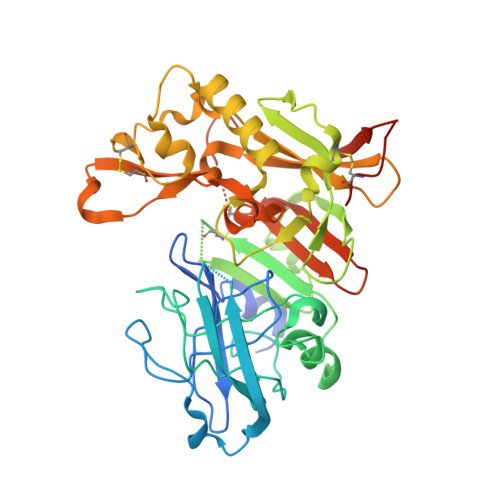Discovery of AZD3839, a potent and selective BACE1 inhibitor clinical candidate for the treatment of Alzheimer disease.
Jeppsson, F., Eketjall, S., Janson, J., Karlstrom, S., Gustavsson, S., Olsson, L.L., Radesater, A.C., Ploeger, B., Cebers, G., Kolmodin, K., Swahn, B.M., von Berg, S., Bueters, T., Falting, J.(2012) J Biol Chem 287: 41245-41257
- PubMed: 23048024
- DOI: https://doi.org/10.1074/jbc.M112.409110
- Primary Citation of Related Structures:
4B05 - PubMed Abstract:
β-Site amyloid precursor protein cleaving enzyme1 (BACE1) is one of the key enzymes involved in the processing of the amyloid precursor protein (APP) and formation of amyloid β peptide (Aβ) species. Because cerebral deposition of Aβ species might be critical for the pathogenesis of Alzheimer disease, BACE1 has emerged as a key target for the treatment of this disease. Here, we report the discovery and comprehensive preclinical characterization of AZD3839, a potent and selective inhibitor of human BACE1. AZD3839 was identified using fragment-based screening and structure-based design. In a concentration-dependent manner, AZD3839 inhibited BACE1 activity in a biochemical fluorescence resonance energy transfer (FRET) assay, Aβ and sAPPβ release from modified and wild-type human SH-SY5Y cells and mouse N2A cells as well as from mouse and guinea pig primary cortical neurons. Selectivity against BACE2 and cathepsin D was 14 and >1000-fold, respectively. AZD3839 exhibited dose- and time-dependent lowering of plasma, brain, and cerebrospinal fluid Aβ levels in mouse, guinea pig, and non-human primate. Pharmacokinetic/pharmacodynamic analyses of mouse and guinea pig data showed a good correlation between the potency of AZD3839 in primary cortical neurons and in vivo brain effects. These results suggest that AZD3839 effectively reduces the levels of Aβ in brain, CSF, and plasma in several preclinical species. It might, therefore, have disease-modifying potential in the treatment of Alzheimer disease and related dementias. Based on the overall pharmacological profile and its drug like properties, AZD3839 has been progressed into Phase 1 clinical trials in man.
Organizational Affiliation:
Innovative Medicines AstraZeneca, CNS and Pain, 15185 Södertälje, Sweden.

















